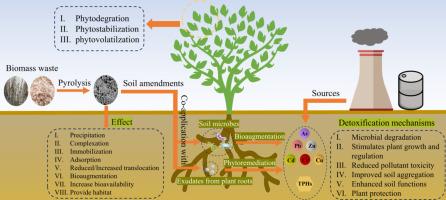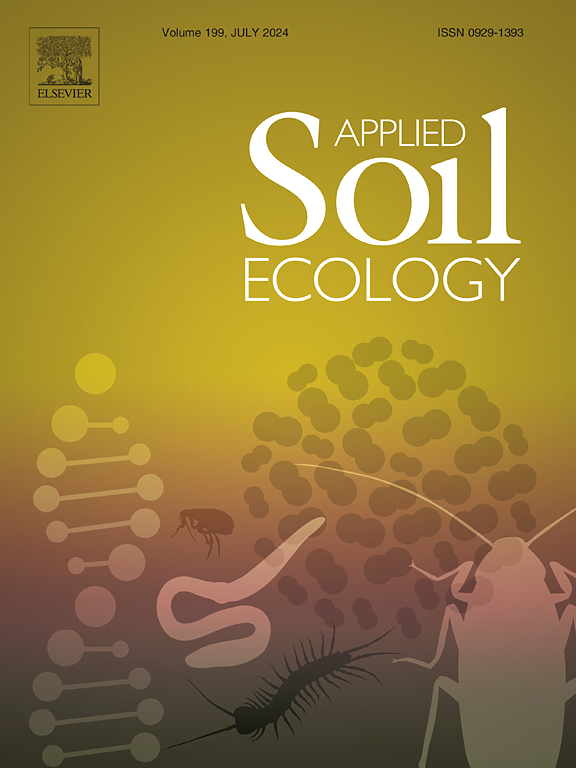生物炭辅助石油碳氢化合物和重金属联合污染土壤的生物修复:综述
IF 4.8
2区 农林科学
Q1 SOIL SCIENCE
引用次数: 0
摘要
土壤中的污染物往往很复杂,其中石油碳氢化合物(PHs)和重金属(HMs)的结合尤其令人担忧。利用植物和相关微生物进行生物修复被认为是去除土壤中 PHs 和 HMs 的最有前途的技术之一。然而,生物修复的修复效率受到微生物活性、植物生长行为和土壤性质的限制。幸运的是,生物炭作为一种具有成本效益且环保的土壤改良剂,在去除 PHs 和固定 HMs 方面显示出巨大的前景。本研究首先回顾了土壤中 PHs 和 HMs 综合污染的现状。然后,综述了生物炭的应用提高了 PHs-HMs 共污染土壤的生物修复效率,强调了参与这两种污染物修复的关键基因,并从分子生物学层面揭示了 PHs 和 HMs 共污染土壤的修复机制。此外,还总结了目前生物炭辅助生物修复的研究成果,阐述了生物炭辅助生物修复 PHs-HMs 污染的合理机制。最后,讨论了生物炭在提高生物修复效果方面面临的挑战和未来展望,并提出了通过整合植物修复、降解微生物和生物炭对 PHs-HMs 共污染土壤的修复策略。这项研究对改善土壤健康和治理联合污染土壤具有积极意义。本文章由计算机程序翻译,如有差异,请以英文原文为准。

Biochar assisted bioremediation of soils with combined contamination of petroleum hydrocarbons and heavy metals: A review
Contaminants in soils tend to be complex, with the combination of petroleum hydrocarbons (PHs) and heavy metals (HMs) being of particular concern. Bioremediation, using plants and associated microorganisms, is considered one of the most promising technologies for the removal of PHs and HMs from soils. However, the remediation efficiency of bioremediation is limited by microbial activity, plant growth behavior and soil property. Fortunately, biochar, as a cost-effective and environmentally friendly soil amendment, shows great promise in the removal of PHs and the immobilization of HMs. This study first reviewed the current situation of combined pollutions of PHs and HMs in soils. It then reviewed the application of biochar enhanced the bioremediation efficiency in the remediation of PHs-HMs co-contaminated soils, and highlighted the key genes involved in the remediation of these two pollutants and revealed the mechanism of remediation of soil co-contaminated with PHs and HMs at the molecular biology level. In addition, the current research results of biochar-assisted bioremediation were summarized and the reasonable mechanisms of biochar-assisted bioremediation of PHs-HMs contamination were illustrated. Finally, the challenges and future perspectives of biochar in enhancing bioremediation were discussed, and the remediation strategies of PHs-HMs co-contaminated soils through integration of phytoremediation, degrading microorganisms and biochar were proposed. This research has positive implications for improving soil health and managing combined contaminated soils.
求助全文
通过发布文献求助,成功后即可免费获取论文全文。
去求助
来源期刊

Applied Soil Ecology
农林科学-土壤科学
CiteScore
9.70
自引率
4.20%
发文量
363
审稿时长
5.3 months
期刊介绍:
Applied Soil Ecology addresses the role of soil organisms and their interactions in relation to: sustainability and productivity, nutrient cycling and other soil processes, the maintenance of soil functions, the impact of human activities on soil ecosystems and bio(techno)logical control of soil-inhabiting pests, diseases and weeds.
 求助内容:
求助内容: 应助结果提醒方式:
应助结果提醒方式:


